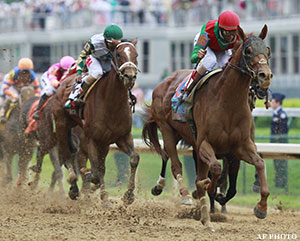In a 50-year span, the four-minute mile went from a human milestone to a starting point for elite runners. The record for the mile has dropped a whopping 17 seconds since Roger Bannister first broke four minutes in 1954.

But in horse racing, the two-minute mile-and-a-quarter is still the holy grail, almost 30 years after Secretariat ran 1:59.40 at the Kentucky Derby in 1973. Only one other racehorse, Monarchos in 2001, has broken the barrier at Churchill Downs since then.
Why?
Harness horses have gotten faster, but not thoroughbreds. In fact, if Secretariat somehow trotted onto your TV screen at the Belmont Stakes this weekend -- huge as he was -- he wouldn't look much different than the other horses. But if the fastest man in the world in 1984, American sprinter Carl Lewis, time-traveled and lined up next to the fastest man in the world now, Usain Bolt, he'd look kind of small. Lewis was 6'3" and 180 lbs.; Bolt is 6'5" and 207. Granted, bigger doesn't always mean faster. Maurice Greene was only 5'9". But over time, humans get taller and their strides get longer. Not so with horses.
Cynics will say the difference is drugs. And although there are some performance enhancing drugs in horse racing and surely in running as well, that doesn't tell the whole story. So let's look at some other differences.
Like shoes. Track shoes have advanced rapidly over the years, and now weigh mere ounces. Michael Johnson's famous golden spikes from 1996 weighed a quarter-pound and would be considered on the heavy side next year at the London Games. But the horseshoes worn at the Belmont this weekend are basically the same as those worn decades ago. "Aluminum shoes have been around for 50 years now," says longtime racetrack veterinarian Luis Castro.

Now go beneath the shoes. Olympic runners a century ago, in the Chariots of Fire era, ran on the equivalent of loose gravel. Now the tracks are so advanced that they almost feel like trampolines beneath a runner's feet. Horses run on dirt tracks, then as now. Put a horse on a polyurethane track, though, and watch times plummet.
But there's a reason horses still run on softer surfaces like grass and dirt, and that brings us to one of the biggest reasons horses haven't gotten faster: their legs.
"A horse's legs can't really take the torque and pounding that a human leg can," says Castro. "It's like running on your middle finger and the hoof is the fingernail. The human foot is so complex, with multiple bones. The horse foot is one digit, one ligament, one tendon. There's a limit to what the horse can do without injuring itself."
And while a human leg injury can heal over time, racehorses who suffer serious leg injuries must often be put down. So while human racing is a win-or-lose affair, horse racing can be a life-or-death situation. Since so much money and time is invested in every top thoroughbred, it's not worth the extra risk to break a track record.

And of course, trainers can talk to humans. Trial and error goes a lot better with verbal feedback. Egos can be stoked. Humans want to be known as the "G.O.A.T." -- greatest of all time. Horses just want to run faster than the next horse.
"People have tried interval training, like on humans," says Castro. "The problem is these horses are pretty young developmentally. A lot of times when you find something that works and doesn't hurt the horse, it's hard to change."
Lastly, racehorses are bred from only six percent of the total stock, so the small gene pool, developed over the course of many generations, doesn't lend itself to significant further change. As Stanford biologist Mark Denny writes in his superb 2008 study on the subject, "Despite intensive programs to breed faster thoroughbreds ... despite increasing populations from which to choose exceptional individuals, and despite the use of any undetected performance-enhancing drugs, race speeds in these animals have not increased in the last 40–60 years. Thus, for horses and dogs, a limit appears to have been reached."
Denny suggests a similar limit is near for humans, but not here yet.
"We have made advancements," says Animal Kingdom trainer Graham Motion, "but there's only so much you can do with a horse."
-- Eric Adelson can be reached at adelson@yahoo-inc.com.




